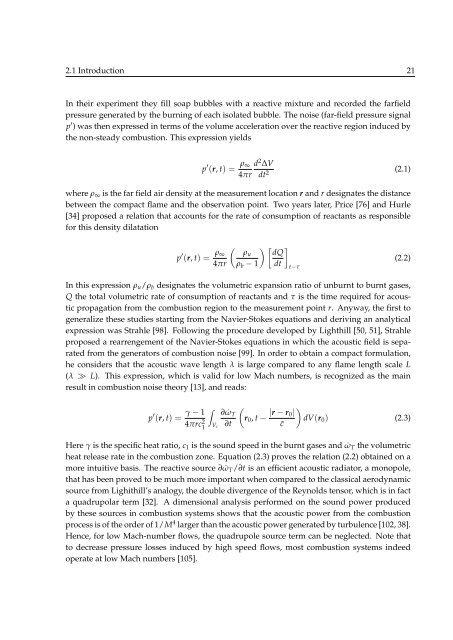THESE de DOCTORAT - cerfacs
THESE de DOCTORAT - cerfacs
THESE de DOCTORAT - cerfacs
Create successful ePaper yourself
Turn your PDF publications into a flip-book with our unique Google optimized e-Paper software.
2.1 Introduction 21<br />
In their experiment they fill soap bubbles with a reactive mixture and recor<strong>de</strong>d the farfield<br />
pressure generated by the burning of each isolated bubble. The noise (far-field pressure signal<br />
p ′ ) was then expressed in terms of the volume acceleration over the reactive region induced by<br />
the non-steady combustion. This expression yields<br />
p ′ (r, t) = ρ ∞ d 2 ∆V<br />
4πr dt 2 (2.1)<br />
where ρ ∞ is the far field air <strong>de</strong>nsity at the measurement location r and r <strong>de</strong>signates the distance<br />
between the compact flame and the observation point. Two years later, Price [76] and Hurle<br />
[34] proposed a relation that accounts for the rate of consumption of reactants as responsible<br />
for this <strong>de</strong>nsity dilatation<br />
p ′ (r, t) = ρ ( ) [ ]<br />
∞ ρu dQ<br />
4πr ρ b − 1 dt<br />
t−τ<br />
(2.2)<br />
In this expression ρ u /ρ b <strong>de</strong>signates the volumetric expansion ratio of unburnt to burnt gases,<br />
Q the total volumetric rate of consumption of reactants and τ is the time required for acoustic<br />
propagation from the combustion region to the measurement point r. Anyway, the first to<br />
generalize these studies starting from the Navier-Stokes equations and <strong>de</strong>riving an analytical<br />
expression was Strahle [98]. Following the procedure <strong>de</strong>veloped by Lighthill [50, 51], Strahle<br />
proposed a rearrengement of the Navier-Stokes equations in which the acoustic field is separated<br />
from the generators of combustion noise [99]. In or<strong>de</strong>r to obtain a compact formulation,<br />
he consi<strong>de</strong>rs that the acoustic wave length λ is large compared to any flame length scale L<br />
(λ ≫ L). This expression, which is valid for low Mach numbers, is recognized as the main<br />
result in combustion noise theory [13], and reads:<br />
p ′ (r, t) = γ − 1 ∫ (<br />
∂ ˙ω T<br />
4πrc 2 1 V c ∂t<br />
r 0 , t − |r − r 0|<br />
¯c<br />
)<br />
dV(r 0 ) (2.3)<br />
Here γ is the specific heat ratio, c 1 is the sound speed in the burnt gases and ˙ω T the volumetric<br />
heat release rate in the combustion zone. Equation (2.3) proves the relation (2.2) obtained on a<br />
more intuitive basis. The reactive source ∂ ˙ω T /∂t is an efficient acoustic radiator, a monopole,<br />
that has been proved to be much more important when compared to the classical aerodynamic<br />
source from Lighithill’s analogy, the double divergence of the Reynolds tensor, which is in fact<br />
a quadrupolar term [32]. A dimensional analysis performed on the sound power produced<br />
by these sources in combustion systems shows that the acoustic power from the combustion<br />
process is of the or<strong>de</strong>r of 1/M 4 larger than the acoustic power generated by turbulence [102, 38].<br />
Hence, for low Mach-number flows, the quadrupole source term can be neglected. Note that<br />
to <strong>de</strong>crease pressure losses induced by high speed flows, most combustion systems in<strong>de</strong>ed<br />
operate at low Mach numbers [105].
















